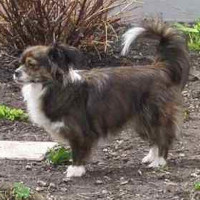Appearance of the Shelillion
|
| The Shelillion is a very small canine, with a back slightly longer than the dog's waist, and a fine bone structure. Continental Papillon Miniature Spaniel dogs generally have a fairly round skull with a fox-like face and a fine muzzle that is slightly shorter than average, while Shetland Sheepdogs tend to have a flat, wedge-shaped head with a longer, more substantial muzzle. Although these crossbred dogs may closely resemble either of their parent breeds, they generally fall somewhere in between, with a slightly rounded head and a well-balanced but slightly narrow muzzle. Their eyes can be round or almond-shaped and are most often dark brown, although blue or parti-colored eyes are sometimes found. Their ears are medium to large, well furred and generally erect, although some Shelillion ears are only three-quarters carried, and a few have inherited the floppy ears of the Phalene variety of Continental Toy Spaniel. |
Temperament of the Shelillion
|
| The Shelillon is descended from two breeds known for being feisty, friendly and outgoing, and is likely to inherit these characteristics too, although it can be prone to separation anxiety and become destructive if left alone for long periods or not given enough mental stimulation to keep it occupied. They are quite good with children and make excellent family pets, tolerant even with young children, but some can be hyper-reactive to touch, loud sounds or rapid movement, making supervision very important, and they can be prone to chasing or herding other animals. Socialization and training are extremely important for this small canine to prevent the development of negative traits such as shyness and obsessive barking, and to encourage positive mental growth. This hybrid is generally very intelligent and extremely easy to train, often learning tricks easily and excelling in obedience trials, although it can sometimes show a rebellious side due to its Papillon heritage and those who take after the Sheltie can become defensive if treated too harshly. |
Needs and activities of the Shelillion
|
| This cross-breed needs a moderate amount of exercise a day, and will generally settle for 45 minutes a day of vigorous activity, divided into two or three shorter sessions. However, if you're looking for a partner for slightly longer walks, the Shelillon is likely to come along happily and do a perfectly respectable job of keeping up the pace. These dogs can also enjoy other activities, such as agility training, herding exercises, puzzles and ball games, indoors or out. It's important to take weather conditions into account when exercising outdoors, especially with dogs that have the thick double coat most often seen in the Shetland Sheepdog, as they may be slightly more sensitive to high temperatures. |
Maintenance of the Shelillion
|
| The coat of this hybrid is universally quite long, but can vary considerably from dog to dog in terms of density, texture and amount of shedding. The Sheltie has a thick, double-layered coat. Neither coat requires frequent bathing, as they are naturally dirt-resistant and low-odour, but both need brushing at least several times a week. Shelillons that have inherited the Papillon's single-layer silky coat are not generally prone to shedding or matting, but brushing is necessary to remove dirt and debris from the coat and to avoid small tangles, while those with the double-layered coat of the Shetland Sheepdog shed more and are more likely to form mats, which can be particularly troublesome when they develop close to the skin in the undercoat and may require more frequent brushing. |









 English (United Kingdom)
English (United Kingdom)